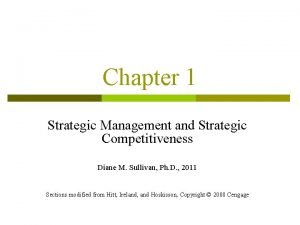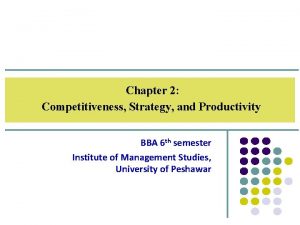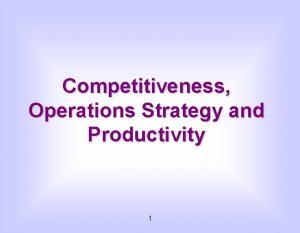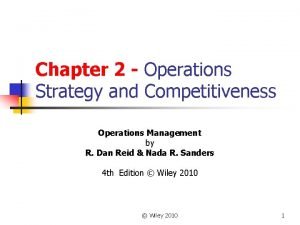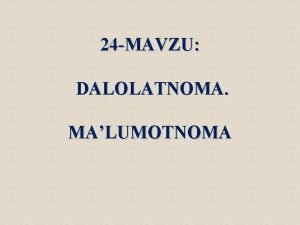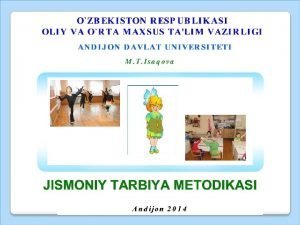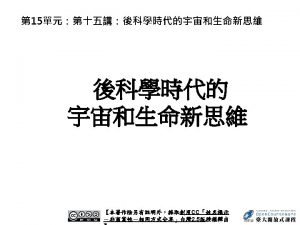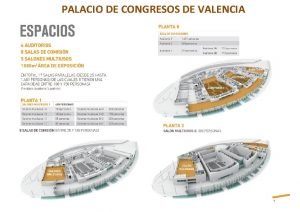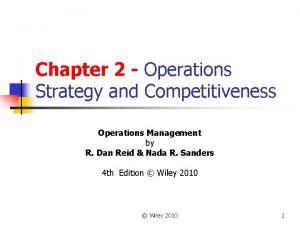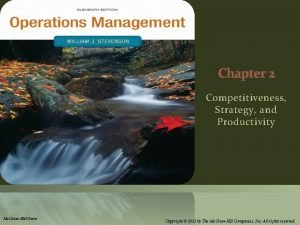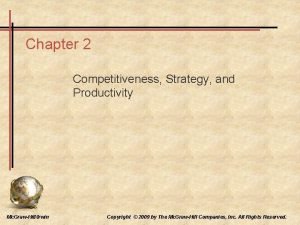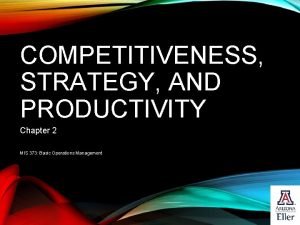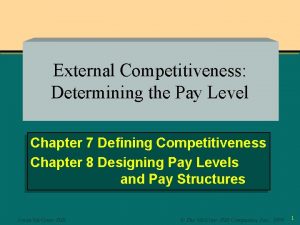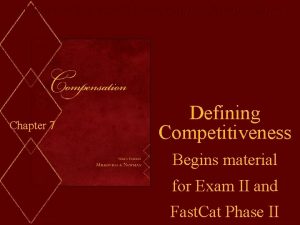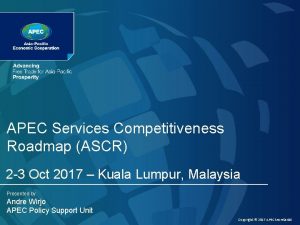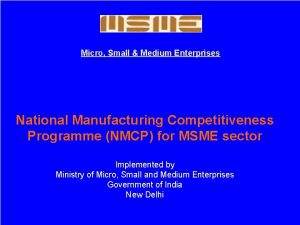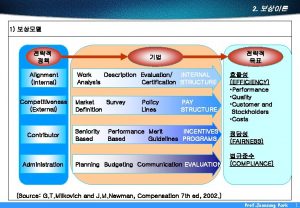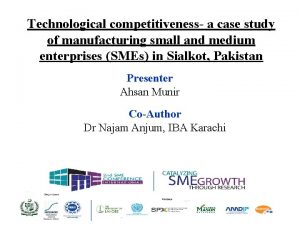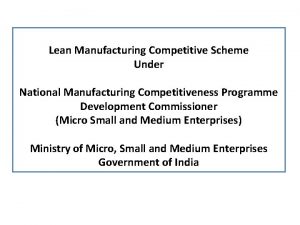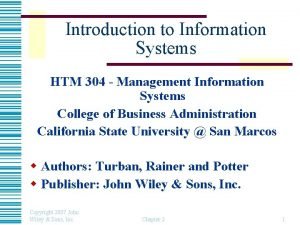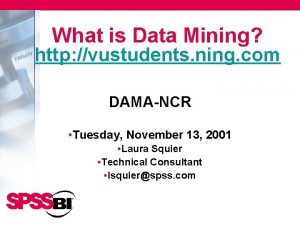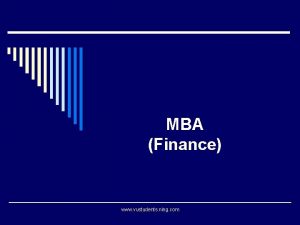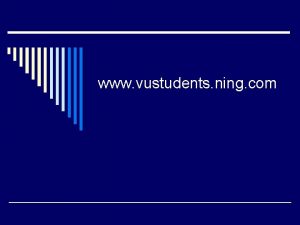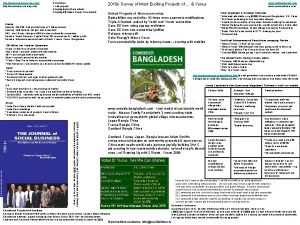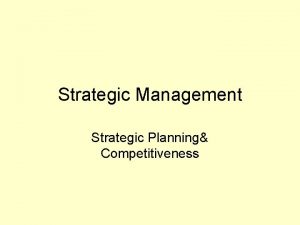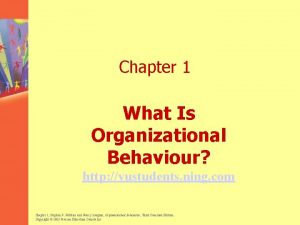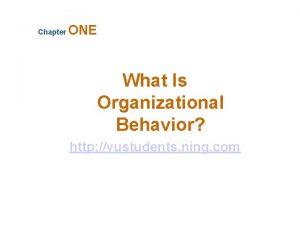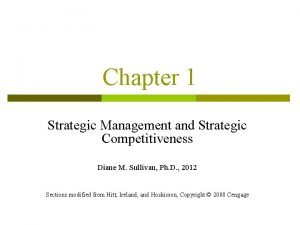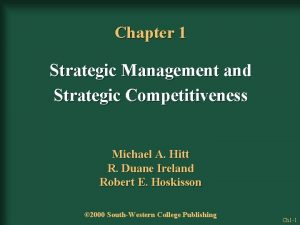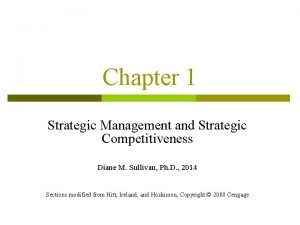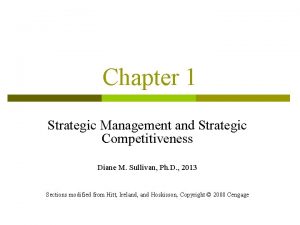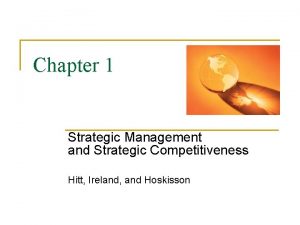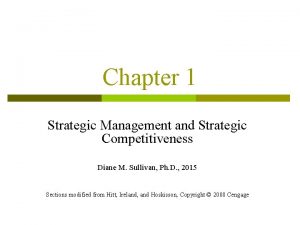Strategic Management and Strategic Competitiveness http vustudents ning































- Slides: 31

Strategic Management and Strategic Competitiveness http: //vustudents. ning. com/ n Overview n Nature of Competition n I/O Model of Above-Average Returns (AAR) n Resource-Based Model of AAR n Strategic Vision and Mission n Stakeholders n Strategic Leaders n The Strategic Management Process n What is Performance? http: //vustudents. ning. com/ 1

What is Strategic Management? n analyze competitive situation n develop strategic goals n devise plan of action n allocate resources n implement plan n evaluate results http: //vustudents. ning. com/

The Process of Strategic Management Environment al Analysis Mission Statemen t §Competition/ Industry Structure §Regulations §Technology §Market Trends §Economic Trends Organization Self-Assessment Resources §Financial §Physical §Human §Technological §Capital Management Systems §Culture §Structure §Power Dynamics/Politics §Decision Making Processes §Past Strategy and Performance §Work Systems http: //vustudents. ning. com/ Identify Assumptions Goals & Objective s Strategy

Solectron Mission Statement “Our mission is to provide world wide responsiveness to our customers by offering the highest quality, lowest total cost, customized, integrated, design, supply-chain and manufacturing solutions through longterm partnerships based on integrity and ethical business practices. ” http: //vustudents. ning. com/

Strategy Formulation Strategy Implementation HR Practices Recruiting SWOT Mission Goals Job Design Selection Training Development Performance Pay Structure Management Incentives Benefits Job Analysis Labor Relations Employee Relations Strategic Choice Human Resource Capability Human Resource Actions Skills Behaviors Skills Abilities Behaviors Knowledge Results (Productivity, Absenteeism, Turnover) Human Resource Needs Culture http: //vustudents. ning. com/ Emergent Strategies Firm Performance Productivity Quality Productivity Strategy Evaluation

Nature of Competition: Basic concepts n Strategy n Integrated and coordinated set of commitments and actions designed to exploit core competencies and gain a competitive advantage n Competitive Advantage (CA) n When a firm implements a strategy that competitors are unable to duplicate or find too costly to imitate n Strategic Competitiveness n Achieved when a firm successfully formulates & implements a value-creating strategy http: //vustudents. ning. com/ 6

Nature of Competition: Basic concepts n Above Average Returns n Returns in excess of what investor expects in comparison to other investments with similar risk n Risk n Investor’s uncertainty about economic gains/losses resulting from a particular investment n Average Returns n Returns equal to what investor expects in comparison to other investments with similar risk n Strategic Management Process (SMP) n Full set of commitments, decisions and actions required for a firm to achieve strategic competitiveness and earn above average returns http: //vustudents. ning. com/ 7

The Strategic Management Process http: //vustudents. ning. com/ 8

Industrial Organizational (I/O) Model of Above-Average Returns (AAR) n Explains the external environment’s dominant influence on a firm's strategic actions and performance n Characteristics of and conditions present in the external environment determine the appropriateness of strategies that are formulated and implemented in order for a firm to earn above-average returns. n The choice of industry in which to compete has more influence on firm performance than the decisions made by managers inside the firm. http: //vustudents. ning. com/ 9

Industrial Organizational (I/O) Model of Above-Average Returns (AAR) n 4 Underlying Assumptions n n External environment imposes pressures and constraints that determine the strategies resulting in AAR Most firms that compete within a particular industry: Control similar strategically relevant resources n Pursue similar strategies in light of those resources n Resources for implementing strategies are highly mobile across firms n Therefore any resource differences between firms will be short-lived n n Organizational decision makers are rational and committed to acting in the firm's best interests, as shown by their profit -maximizing behaviors http: //vustudents. ning. com/ 10

Industrial Organizational (I/O) Model of Above. Average Returns (AAR) http: //vustudents. ning. com/ 11

Industrial Organizational (I/O) Model of Above-Average Returns (AAR) n Limitations n Only two strategies are suggested: n Cost Leadership § n Differentiation § n n Produce standardized products at costs below those of competitors - be THE low-cost leader Produce differentiated products that customers are willing to pay a premium price for Internal resources & capabilities are not considered AAR are earned when a firm implements the strategy dictated by external environment (general, industry, and competitor) http: //vustudents. ning. com/ 12

The Resource-Based Model of AAR n Basic Premise - a firm's unique resources & capabilities is the basis for firm strategy and AAR n n Each organization is a bundle of unique resources and capabilities Performance difference between firms emerge over time due to these unique resources and capabilities (versus industry’s structural characteristics) Combined uniqueness should define the firms’ strategic actions Resources are tangible and intangible http: //vustudents. ning. com/ 13

The Resource-Based Model of AAR n Resources n Inputs into a firm's production process n n n Includes capital equipment, employee skills, patents, high-quality managers, financial condition, etc. Basis for competitive advantage: When resources are valuable, rare, costly to imitate, and nonsubstitutable 3 categories of internal/firm-specific resources n n n Physical - things you can touch/feel = tangible Human - people / employees Organizational capital - relative to the firm itself http: //vustudents. ning. com/ 14

The Resource-Based Model of AAR n Capability n Capacity for a set of resources to perform a task or activity in an integrative manner n Core Competency n A firm’s resources and capabilities that serve as sources of competitive advantage over its rival n Summary n A firm has superior performance because of n Unique resources and capabilities, and the combination makes them different, and better, than their competition – driving the competitive advantage http: //vustudents. ning. com/ 15

The Resource. Based Model of AAR http: //vustudents. ning. com/ 16

Vision and Mission http: //vustudents. ning. com/ n Purpose to inform stakeholders of what the firm is, what it seeks to accomplish, and who it seeks to serve n Vision n n Picture of what the firm wants to be and, in broad terms, what it ultimately wants to achieve Gives the firm direction The responsibility of a firm's top strategic leader – the CEO works with others to form a firm’s strategic vision Serves as foundation for mission n Mission n n Specifies the business(es) or industries in which a firm intends to compete and the customers it intends to serve More specific than the vision n Mission and vision provide foundation for strategy formulation and implementation http: //vustudents. ning. com/ 17

Stakeholders n Basic Premise – a firm can effectively manage stakeholder relationships to create a competitive advantage and outperform its competitors n Stakeholders are individuals and groups who can affect, and are affected by, the strategic outcomes achieved and who have enforceable claims on a firm’s performance n Must minimally meet the expectations of each stakeholder group n n AAR make this easier to do 3 Major Stakeholder Groups http: //vustudents. ning. com/ 18

The Three Stakeholder Groups http: //vustudents. ning. com/ 19

Strategic Leaders n People (primarily managers) located in different parts of the firm using the strategic management process to help the firm reach its vision and mission n Decisive and committed to firms’ efforts to achieve their desired strategic outcomes Create and sustain organizational culture Can exist at different organizational levels n Corporate, business, functional, operating http: //vustudents. ning. com/ 20

Strategic Leaders n The Work of Effective Strategic Leaders n n Work long hours Must be able to think strategically n n ”think seriously and deeply…about the purposes of the organizations they head or functions they perform, about strategies, tactics, …. . and people…and about the important questions … they need to ask. ” Set ethical tone for organization Try to predict the outcomes of their strategic decisions before they are implemented Involved in internal and external analyses and strategy formulation and implementation http: //vustudents. ning. com/ 21

The Strategic Management Process http: //vustudents. ning. com/ 22

What is Performance? Performance is central to the study and practice of strategy Organizational performance is complicated Numerous definitions, approaches, and types of performance Can be an elusive concept Examples: n Goal attainment - Vision/mission, objectives n Effectiveness – A hospital curing sick people n Quality – Customer service n Efficiency - Inputs versus outputs n Financial/accounting/economic Returns – ROA, EPS n Can also vary by type of firm n For-profit versus not-for-profit n Publicly traded? n Government n n n http: //vustudents. ning. com/ 23

What is Performance? n Normal Economic Performance n Economic value generated is equal to owners expectations n Below-Normal Economic Performance n Economic value generated is less than owners expectations n Above-Normal Economic Performance n Economic value generated is greater than owners expectations http: //vustudents. ning. com/ 24

4 Major Approaches to Measuring Performance n Firm Survival n A firm that survives over a relatively extended period of time must be generating at least normal economic performance n Strengths § Easy to use § If a firm’s operations are ongoing, the firm is surviving and thus generating at least normal economic value n Weaknesses § When does a firm no longer exist? § Firm death can be protracted § No insights concerning above-normal performance http: //vustudents. ning. com/ 25

4 Major Approaches to Measuring Performance n Multiple Stakeholders View n n An organization’s performance should be evaluated relative to the preferences and desires of stakeholders that provide resources to a firm Stakeholders include n n Customers, Labor, Unions, Management, Top Managers, Suppliers, Partners, Equity Holders, Society at Large, Environment, Communities, Government, Public Interest Groups Different stakeholders can have different interests and different criteria for evaluating performance May need to choose which stakeholders to satisfy Must minimally satisfy the interests of each stakeholder group http: //vustudents. ning. com/ 26

4 Major Approaches to Measuring Performance n Simple Accounting Measures n Most popular approach n Publicly available for many firms n They communicate a great deal of information n Most often rely on ratio analysis n 4 Major categories of ratios n n Profitability Liquidity Leverage Activity http: //vustudents. ning. com/ 27

4 Major Approaches to Measuring Performance n Profitability Ratios n Ratios with some measure of profit in the numerator and some measure of firm size or assets in the denominator n ROA, ROE, margins, EPS, p/e ratio n Liquidity Ratios n Ratios that focus on the ability of a firm to meet its short–term financial obligations n Current ratio, quick ratio http: //vustudents. ning. com/ 28

4 Major Approaches to Measuring Performance n Leverage Ratios n Ratios that focus on the level of a firm’s indebtedness n Debt to assets, debt to equity, times interest earned n Activity Ratios n Ratios that focus on the level of activity in a firm’s business n Inventory turnover, average collection period http: //vustudents. ning. com/ 29

4 Major Approaches to Measuring Performance n Adjusted Accounting Measures n Require the estimate of a firm’s expected performance and its actual performance n Expected performance is reflected in a firm’s cost of capital n Firms with returns less than the cost of capital will be unable to attract additional capital n Firms with returns greater than cost of capital will be able to attract additional capital http: //vustudents. ning. com/ 30

The Relative Nature of Performance n Performance is always relative to other firms n Performance should be compared to industry average(s) n AAR are above industry average n Industry adjustments n Some industries are more profitable than others n Can adjust for industry performance and compare performance levels across industries n Can also adjust for risk n Looking at trends can also be useful n From earlier n I/O Model - Pick attractive industry(ies) to compete in n Resource-Based Model - Develop unique bundles of resources and capabilities http: //vustudents. ning. com/ 31
 Strategic competitiveness
Strategic competitiveness What is strategic competitiveness
What is strategic competitiveness Strategic competitiveness
Strategic competitiveness Distinctive competencies in organizations seldom relate to:
Distinctive competencies in organizations seldom relate to: Operations strategy and competitiveness
Operations strategy and competitiveness Productivity and competitiveness in operations management
Productivity and competitiveness in operations management Cultural aspects of strategy choice
Cultural aspects of strategy choice Hujayra maketini yasash
Hujayra maketini yasash далолатнома образец
далолатнома образец Sonlarning kubini jadvali
Sonlarning kubini jadvali Maruza va uning turlari
Maruza va uning turlari Gimnastika mashqlari
Gimnastika mashqlari Yang chen-ning
Yang chen-ning Ning li cause of death
Ning li cause of death Ning jung
Ning jung Red ning contra
Red ning contra Tagaguhit ng aklat
Tagaguhit ng aklat Sala de congresos valencia
Sala de congresos valencia Chapter 2 operations strategy and competitiveness
Chapter 2 operations strategy and competitiveness Operations management chapter 2
Operations management chapter 2 How do you measure productivity
How do you measure productivity Competitiveness strategy and productivity
Competitiveness strategy and productivity Chapter 2 competitiveness strategy and productivity
Chapter 2 competitiveness strategy and productivity Competitiveness strategy and productivity
Competitiveness strategy and productivity External competitiveness
External competitiveness Pay mix policy alternatives
Pay mix policy alternatives Apec services competitiveness roadmap
Apec services competitiveness roadmap National manufacturing competitiveness programme
National manufacturing competitiveness programme Internal competitiveness
Internal competitiveness Technological competitiveness
Technological competitiveness Lean manufacturing competitiveness scheme
Lean manufacturing competitiveness scheme The best-known framework for analyzing competitiveness is
The best-known framework for analyzing competitiveness is

